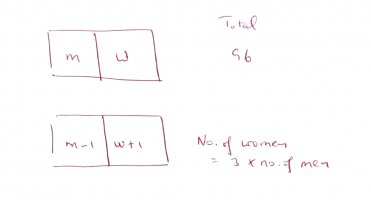I'm still not understanding.
m + w has to equal 96 right? So the first equation has to be m + w = 96
Now we can say that, yes, 32+64=96 (with the number of woman being triple in size compared to the men) but this is not the original number of people at the party. These are the figures after one man has left and one woman has arrived. So with that, could we not assume the original amount of people at the party is 33 men and 63 women which still totals 96, however the amount of women is not 3 times the men at this point as 33x3=99 which can't be true as there is only 96 people. But after 1 man has left and 1 woman has arrived, it still totals to 96 people, however now it is true that there are 3 times as many women as there are men?
So there is obviously a m - 1 and w + 1 here but I just don't understand how to make this into an equation to be solved. I assume that the second part of the question is basically saying that this will be a simultaneous linear equation to solve, or am I perhaps getting to hung up on the terminology, assuming it to be something that it isn't?
I also do not understand, but in my case I do not understand your confusion.
I like to start by identifying how many numbers are initially unknown. And I must admit that the problem as stated is ambiguous.
Let’s fix that.
[math]m = \text {number of men at the party before anyone leaves.}\\
n = \text {number of men at the party after first person leaves.}\\
w = \text {number of women at the party before anyone leaves.}\\
x = \text {number of women at the party after person arrives very late.}[/math]
Can you see that the problem is ambiguous in that we cannot be sure whether we are being asked about the number of men and women before or after the change? Consequently, we are looking for four numbers. We have assigned a distinct letter to each unknown. We have four unknowns. That means a solution requires four equations. (To guarantee a solution further requires that those equations be independent and consistent.)
Now we must translate from English to math.
“There were 96 people at a party” [imath]\implies m + w = 96.[/imath]
“One man leaves” [imath]\implies n = m - 1.[/imath]
”and is replaced by a woman“ [imath]\implies x = w + 1.[/imath]
”leaving three times as many woman as men” \implies [imath]\implies 3n = x.[/imath]
The real difficulty in translation is in fully understanding the English. And do you see how much easier it is if every unknown number is given its own letter? For some
IDIOTIC reason, the normal way to teach is to minimize the number of letters and make students solve admittedly easy algebra problems in their heads before writing anything down.
Now we have four equations in four unknowns. The general way to solve these systems is to express one unknown in terms of one or more of the other unknowns and then replace that unknown in all the other equations. We keep doing that until we have one equation in one unknown and solve that through basic algebra. In this case, it is really easy because two of our equations already express one unknown in terms of another.
[math]n = m - 1 \text { and } 3n = x \implies 3(m - 1) = x \implies 3m - 3 = x.[/math]
[math]x = w + 1 \text { and } 3m - 3 = x \implies 3m - 3 = w + 1 \implies w = 3m - 4.[/math]
We have now reduced our system to two equations in two unknowns, namely
[math]w + m = 96 \text { and } 3m - 4 = w.[/math]
Now complete the process of reducing to one equation in one unknown and solve that last equation.That gives you one of the unknown numbers. Now go back and solve for the remaining numbers.
What harry told you was how to check your answers, not find them.

